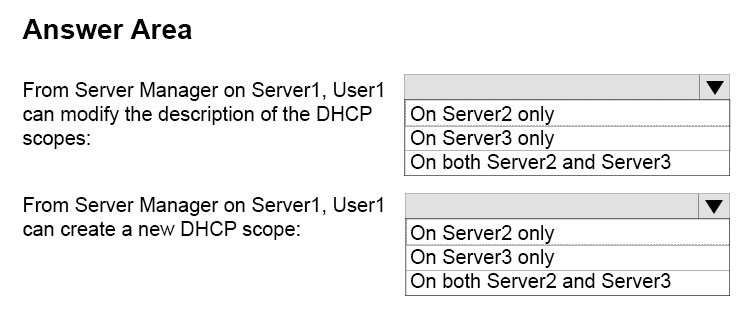HOTSPOT
Your network contains an Active Directory domain named contoso.com. The domain contains three servers named Server1, Server2, and Server3 that run Windows Server 2016.
Server1 has IP Address Management (IPAM) installed. Server2 and Server3 have the DHCP Server role installed and have several DHCP scopes configured. The IPAM server retrieves data from Server2 and Server3.
A domain user named User1 is a member of the groups shown in the following table.
On Server1, you create a security policy for User1. The policy grants the IPAM DHCP Scope Administrator Role with the \\Global access scope to the user.
Which actions can User1 perform? To answer, select the appropriate options in the answer area.
Hot Area:

Explanation:
User1 is using Server Manager, not IPAM to perform the administration. Therefore, only the “DHCP Administrators” permission on Server2 and the “DHCP Users” permissions on Server3 are applied.
The permissions granted through membership of the “IPAM DHCP Scope Administrator Role” are not applied when the user is not using the IPAM console.



Wrong anwser. Ipam is build into Server manager, so first anwser is wrong
2
2
Both can be done from server 2 and 3, both anwsers
10
0
As noted by Nobody, answer is Server2 & Server3 for both answers.
From Server Manager (IPAM tab), User1 can configure DHCP Scope on server2 & server3.
If user1 was launching DHCP Admin console from Server Manager and using it, then they would no longer be using Server Manager and would therefore only be able to modify Server2.
8
0
I agree with nobody explanation, and as well with musiman explanation given there: https://www.briefmenow.org/microsoft/which-actions-can-user1-perform-8/
for both question the last answer “On both…” is correct.
7
0
yes
Server Manager include
IPAM console
1
0
wrong answer…it should be both
2
0